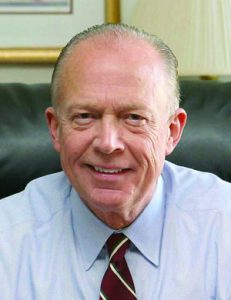Lessons from Hugo
September 17, 2014By Richard Eckstrom
S.C. Comptroller
It’s been a quarter century since South Carolina felt the wrath of Hurricane Hugo, but it remains a defining moment for our state.Shortly before midnight on Sept. 21, 1989, a category 4 hurricane made landfall near Charleston, battering our coastline, destroying homes, and downing power lines.Many coastal residents evacuated their homes, either taking refuge at shelters established at schools and community centers or scrambling further inland to get away from the coast. Those who stayed behind emerged the next morning to the scene of uniformed troops from both the S.C. National Guard and S.C. State Guard patrolling a scarred landscape resembling a war zone.
Thirteen people died during the initial onslaught, and dozens of deaths were later attributed to Hugo’s aftermath.
With sustained winds reaching 140 miles per hour, Hugo had remained strong as it made its way to Columbia, continuing to topple trees and cause power outages as far north as Charlotte. It caused $7 billion in damage in the U.S., mostly in South Carolina.
To South Carolinians of a certain age, it remains the storm to which all other hurricanes are compared.
While the visible scars have long healed, Hugo offered important lessons that remain applicable today.
Chief among those lessons is this: Our leaders can never, ever afford to stop planning for the worst. We must always remain focused – preparing and striving to improve.
Protecting citizens from danger is supposed to be government’s highest priority. That’s important to remember in a time when the tendency of government is to delve into new territory, which can sometimes make our leaders less attentive to core functions like public safety and security.
The Hugo response had its successes and failures. Ultimately, we were blessed to have leaders like then-Gov. Carroll Campbell and Charleston Mayor Joe Riley, who worked together to execute evacuation and recovery plans. It’s notable that they were able to convince many people to evacuate before the hurricane approached – an accomplishment only trusted leaders can pull off.
But even while receiving high marks from the public, both recognized the need for improvements, including better evacuation procedures, coordination among agencies, and communication with the public. To give just one example, the state has now provided for lanes on major highways to be reversed to speed evacuations making South Carolina better able today to weather such a disaster.
And then there’s the reminder about the critical roles of our first-responders, public safety officers and other emergency workers.
Unpaid S.C. State Guardsmen with chainsaws opened some of the first passable eastbound traffic lanes within hours of Hugo’s passing. That was one of my first impressions of the State Guard. I was amazed to learn that its members performed their services unpaid. I later joined and rose through the ranks, and in June I retired after serving my last three years as the State Guard’s Commander. It’s worth mentioning that Gov. Nikki Haley designated the first week in June – which is the official start of the annual hurricane season – as “South Carolina State Guard Week” to recognize the role the Guard plays following disasters protecting life and property and assisting with recovery efforts.
Unfortunately, it sometimes takes a catastrophe to draw attention to the responsibilities, and risks, taken on by police, firemen, and National and State Guardsmen.
Hugo’s devastation offered lessons in the resilience of our state, and in the strength of character of our people.
In addition to the loss it inflicted on individuals, the storm was a huge economic drain on the state overall. But what followed was a remarkable recovery.
In the storm’s immediate aftermath there was an outpouring of help: Neighbors helped neighbors. People chipped in to assist in relief efforts. Citizens came together like seldom before to collect food donations, raise money, and clean up communities. Congregations caravanned to the hardest-hit areas to help rebuild churches and community centers.
It set the stage for a recovery that came sooner than many thought possible. Buoyed by a spirit of optimism, South Carolina bounced back. Victims got on with their lives, and communities rebuilt. It was a time of renewal.
It’s worth noting that South Carolina received just $500 million in federal aid – a paltry sum by today’s standards in which tens of billions of dollars are doled out routinely for storm relief efforts. Yet our will to rebuild was strong.
Our state’s subsequent rebuilding boom is credited by economists with helping South Carolina stave off for more than a year the effects of the national recession of the early 90s.
In the quarter-century since Hugo, those areas most affected by the hurricane — the coastline and inland from Beaufort County to Horry County — have recovered and are thriving. That, and an ever-watchful eye on the ocean each June-November, is Hugo’s legacy.
Richard Eckstrom is a CPA and the state’s Comptroller.














